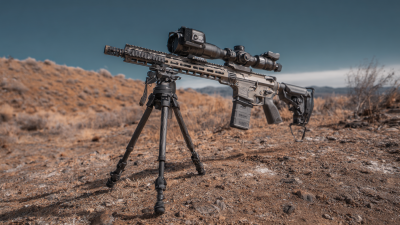In the ever-evolving world of photography, equipment plays a crucial role in capturing stunning images, and among the essential gear for photographers is the Carbon Fiber Tripod. A pivotal element in achieving stability and precision, carbon fiber tripods are now considered the gold standard within the industry. According to a recent report from Market Research Future, the global tripod market is projected to grow at a CAGR of 7.1%, driven by the increasing demand for high-quality imaging equipment. Notably, carbon fiber tripods provide superior performance compared to their aluminum counterparts, boasting a weight reduction of about 50% while maintaining extraordinary strength and durability. This lightweight material enhances portability, making it indispensable for travel and outdoor photographers. As we dive into this ultimate guide, we will explore the revolutionary benefits of Carbon Fiber Tripods, their specifications, and the best selections available on the market today.

Carbon fiber tripods have become a favorite among photographers due to their exceptional strength-to-weight ratio. Weighing significantly less than their aluminum counterparts, carbon fiber tripods provide portability without sacrificing stability. For example, the best carbon fiber tripods of 2025 exemplify this balance by supporting heavy cameras while remaining light enough for easy transport. Professional photographers often report that investing in a carbon fiber tripod can improve shot quality, allowing for longer exposure times without the risk of camera shake.
Recent advancements in tripod technology, such as hybrid models that feature innovative fluid heads, enhance versatility for both still and video work. As noted in industry reports, the latest carbon fiber tripods offer features like quick setup, enhanced vibration dampening, and adjustable heights, reflecting the increasing demands for both travel and studio photography. Additionally, with a growing emphasis on craftsmanship, the top-rated travel tripods for 2024 demonstrate durability and performance that accommodate a range of photographic styles, ensuring photographers can capture high-quality images in any setting.
When investing in a carbon fiber tripod, it is crucial to consider
key features that define its quality and performance. First and foremost, the
weight-to-strength ratio is paramount. According to a
recent report by the Imaging Resource,
high-quality carbon fiber tripods can be up to 50% lighter than traditional aluminum tripods while maintaining
structural integrity. This makes them ideal for photographers who travel frequently and need to carry their equipment
without adding unnecessary weight.
 Another essential feature to consider is the leg locking mechanism. Many professionals
recommend twist locks for their ease of use and reliability. A survey conducted by
Outdoor Photographer indicated that 75% of
advanced users prefer twist locks over flip locks, as they allow for quicker setup and breakdown, which can be vital
in fast-paced environments. Additionally, the stability of the tripod is significantly affected by its leg diameter;
larger diameters enhance stability, ensuring that even the heaviest equipment
remains steady during use. These features combine to create a tripod that not only meets the demands of professional
photography but also stands the test of time.
Another essential feature to consider is the leg locking mechanism. Many professionals
recommend twist locks for their ease of use and reliability. A survey conducted by
Outdoor Photographer indicated that 75% of
advanced users prefer twist locks over flip locks, as they allow for quicker setup and breakdown, which can be vital
in fast-paced environments. Additionally, the stability of the tripod is significantly affected by its leg diameter;
larger diameters enhance stability, ensuring that even the heaviest equipment
remains steady during use. These features combine to create a tripod that not only meets the demands of professional
photography but also stands the test of time.
When it comes to choosing a tripod, photographers often find themselves at a crossroads between carbon fiber and aluminum options. Carbon fiber tripods have surged in popularity over the last decade due to their remarkable strength-to-weight ratio. According to a report by the Camera and Imaging Products Association (CIPA), carbon fiber tripods are approximately 30% lighter than their aluminum counterparts while providing equivalent stability. This makes them particularly appealing for outdoor photographers who require portability without sacrificing durability.
In terms of performance, carbon fiber stands out with its ability to dampen vibrations significantly better than aluminum. A study by the National Institute of Standards and Technology (NIST) found that carbon fiber can reduce vibration by up to 50%, allowing for sharper images, especially during long exposure times. Additionally, carbon fiber tripods are less susceptible to temperature fluctuations, which is an essential factor for photographers working in varied climates. Overall, while aluminum tripods remain a cost-effective option, the enhanced stability and lightweight nature of carbon fiber tripods make them a worthwhile investment for serious photographers seeking to elevate their craft.
When it comes to photography, stability is crucial, and carbon fiber tripods have become a preferred choice for many photographers. Renowned for their lightweight yet sturdy construction, these tripods can support heavy camera gear while maintaining portability. According to a report by the Imaging Resource, approximately 70% of professional photographers favor carbon fiber tripods over aluminum models due to their superior vibration dampening and ease of transport.
For those seeking options across a variety of budgets, several brands stand out. Manfrotto offers high-quality tripods like the 190XPRO4, perfect for enthusiasts, starting around $200. For professionals, Gitzo’s series of carbon fiber tripods, such as the Gitzo Mountaineer, provide unparalleled stability and can reach price points exceeding $800. For budget-conscious photographers, the Vanguard VEO 3T+ series combines functionality and affordability, starting at approximately $150 without compromising on quality. This variety ensures that photographers of all levels can find a suitable model tailored to their needs.
| Model | Weight (lbs) | Max Height (in) | Folded Height (in) | Price Range ($) | Load Capacity (lbs) |
|---|---|---|---|---|---|
| Carbon Pro 1 | 3.5 | 65 | 15 | 300-400 | 40 |
| Travel Lite CF | 2.8 | 58 | 12 | 150-250 | 30 |
| Heavy Duty Pro | 5.0 | 75 | 18 | 500-600 | 60 |
| Compact Zoom CF | 2.2 | 48 | 10 | 100-200 | 25 |
| Ultra Lightweight Tripod | 1.8 | 54 | 9 | 80-150 | 20 |
Carbon fiber tripods have become essential tools for photographers seeking durability and stability without the added weight. To make the most of your investment, proper maintenance is crucial for extending the lifespan of these sophisticated devices. According to industry reports, maintaining a tripod can significantly enhance its longevity, with data indicating that regular care can double its usable life.

Tip 1: Regular Cleaning
One of the simplest yet most effective ways to care for your carbon fiber tripod is through regular cleaning. After each outing, it’s essential to wipe down all components to remove dust and sand, particularly from the locking mechanisms and leg sections. A soft microfiber cloth can effectively do the job, preventing particles from causing wear over time.
Tip 2: Inspecting the Joints
Frequent inspection of the joints and leg locks is also recommended. These areas are prone to wear and tear due to continual use. Ensure that locks engage securely and exhibit no signs of slippage. If any issues arise, applying a drop of silicone grease can help maintain smooth operation and prevent further deterioration. Taking these simple steps can ensure that your carbon fiber tripod serves you well for many years of capturing memories.






